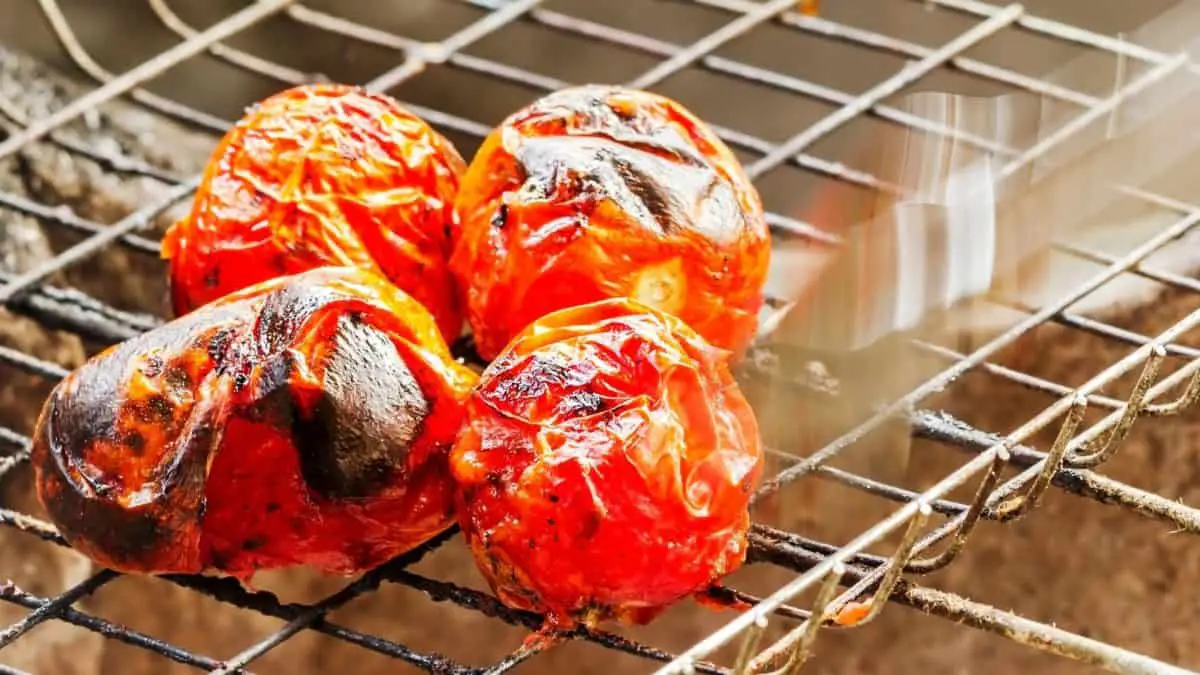If you’re about to host a BBQ party at home for your family or friends, don’t forget to look at smoked tomatoes!
BUT, you must choose the right kind of wood for smoking them because they’re just so delicate. Protect that flavor at all costs.
Here’s everything I know about just the right smokey flavor to keep those tomatoes tender, juicy, and flavorful. Read on to learn!

The best wood for smoking tomatoes is hardwood. Fruity, light-flavored hardwoods work best for adding the right kind of flavor notes and apple is the best choice. As tomatoes have a soft texture and they can be cooked quickly, it’s better to use wood chips for a short smoking session.
Not only the flavor but the texture and freshness of the tomatoes significantly depend on the type of wood, which can then be used for making scrumptious salsa, vegetable smoked sandwiches, or even to eat raw.
In this post we'll cover:
Which Woods Are Best for Smoking Tomatoes?
You may already know that there are two main types of wood: softwood and hardwood.
Softwood’s basically from the group of conifers, and it’s high in resin or sap. This tends to not only work against your fire box but also gives a pungent flavor to your meals. Moreover, it also burns hot and fast.
Therefore, softwood is a big no-no for smoking tomatoes, the flavors don’t accentuate them. On the other hand, you have hardwood. Now, you may ask what hardwood is.
Hardwood comes from trees that produce nuts or fruits, and they usually burn slowly and hot. Hence, it’s ideal to use this wood type for smoking tomatoes.
You can also find lighter (fruity) hardwood on the market to ensure it gives the right taste to the tomatoes. There are a variety of flavors of hardwood that you can use to give the kind of flavor to tomatoes that best satisfy your taste buds.
Although the choice of flavors ultimately narrows down to individual preference, here are some of the flavors that you should try for smoking fresh tomatoes:
- Apple – It is one of the commonly used wood kinds, and it comes with a sweet, fruity, and mild taste.
- Maple – One of the versatile wood types, maple has a sweet and subtle flavor to it. At the same time, it can give a mildly smoky taste to your tomatoes too.
- Alder – If you’re looking for delicate and sweet, musky smoke taste, alder wood will be your best bet for smoking tomatoes.
- Almond – Some people prefer a subtle, nutty flavor in fruits and vegetables. If you’re also one of them, you should go for almond wood.
- Cherry – This wood type can either produce a sweet or sour smoky taste depending on the kind of tree it was harvested from.
- Pear – Mildly sweet and smoky flavor, kind of similar to apple wood.
- Pecan – Sweet and nutty flavor and a great, subtle alternative to hickory wood.
Why Do These Flavors Work Well for Tomatoes?
The reason why the wood flavors that we have mentioned above work well for smoking tomatoes is that they have a sweet, smoky flavor to them.
Tomatoes are delicate ingredients, and using strong flavors will overpower them, therefore, making them lose their natural flavor.
These light wood types will make sure you get a hint of BBQ flavor while enjoying the savor of fresh, juicy tomatoes to complement your meal.
How Long Do You Need to Smoke Tomatoes?
Whether you’re about to smoke cherry or regular tomatoes, it can take anywhere between 45 to 60 minutes. It depends on how soft and smoked you want the tomatoes to be.
Wood Chunks or Chips for tomatoes?
Wood chips are readily available, and they’re ideal for smoking tomatoes as they have a short cooking time and they burn more quickly. You should also pre-soak wood chips if you’re in that camp, preferably the night before smoking, but I strongly advise people not to soak their wood chips.
Remember that you shouldn’t use wood more than required for a short smoking session. So, a handful of wood chips will be enough to add smoky flavor while maintaining the original taste of tomatoes.
On the other hand, it’s not quite convenient to find wood chunks in the market, and they are ideal for meals that take longer cooking time, such as meat (like these top choices to smoke). It doesn’t require you to pre-soak it.
However, people use both wood chips and chunks to smoke tomatoes. Although it’s better to smoke tomatoes with wood chips, you can check for yourself and see what works best for you.
Which Woods Should You Avoid When Smoking Tomatoes?
The general rule of thumb is to avoid wood that contains stains of paint, preservatives, or other chemical treatments as it isn’t good health- and taste-wise. For this, you should check the details on the packaging before buying.
Moreover, wood covered in mold or fungus should be completely avoided due to the reasons mentioned right above.
You shouldn’t use strong-flavored or fast-burning hardwood for smoking tomatoes as it won’t complement their taste and texture. Some of the flavors of hardwood to avoid are:
- Hickory – It provides a strong smoky flavor, and it isn’t recommended to use it with tomatoes.
- Walnut –Walnut wood contains a super strong flavor, and it can easily become bitter as well.
- Mesquite – Although it is slightly sweeter than hickory wood, it is still one of the strongest-flavored woods. While tomatoes are delicate in nature, mesquite wood burns quite hot and fast. Therefore it should be avoided for smoking tomatoes.

